Are there sailing terms you need to know? And if yes, what are they? Allow me first to step sideways for a moment before I answer that question…In London, over the course of eight years, I built up a successful company. To quietly grab market share from the top three competitors in my marketplace I simply did one major thing that my competitors did not. My competitors all used industry lingo while trying to sell to ‘normal’ people. While researching my rivals marketing materials and sales pitch I realized that the everyday person would struggle to understand what the company was truly offering.
I changed the industry lingo to everyday plain language and watched my market share increase exponentially. Normal people, like you and I, like to understand the environment we’re in. We like to feel at home with the language being used.
Similarly, in the sailing world, there is a massive amount of industry lingo.
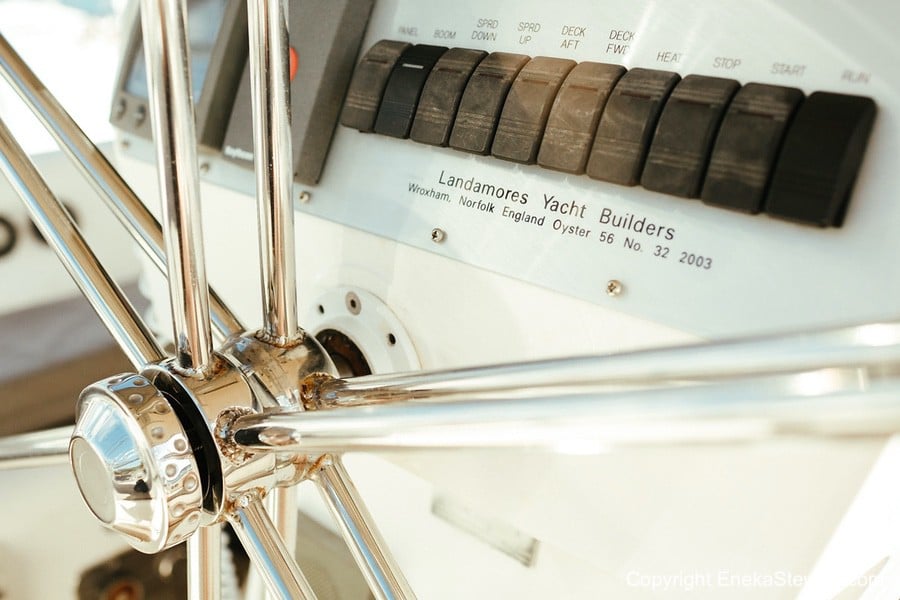
Salty sea dogs and even young professional crew (know-it-alls) like to scowl at those that don’t use the proper boating terms. It’s unfortunate but some people like to find fault in others and point out where they get it wrong rather than support and offer mentorship.
Sailing is an old profession and with it comes the old ways of secrecy, big egos and a mentality of ‘you must pay your dues and learn the hard way…’
I can’t tell you how many times I’ve used the wrong sailing term and received loads of unkind comments and emails sending me corrections – usually from armchair sailors (the kind that knows everything about sailing but doesn’t actually sail).
When entering the world of sailing the terminology can create quite a barrier for newbies and those that aren’t yet sure whether sailing is for them or not.
I find that there’s often one person that has the sailing dream and that person is trying to get their partner or partner/family to buy into the dream. It’s one thing to sell the dream and another to make it happen – especially when there’s so much to learn (sailing lingo included!).

Often, newbies feel pressured to know every term, understand the full physics of how a sailboat sails and look like a professional from day one. That’s a lot of pressure for the dreamer, let alone the one that’s going along with the grand plan. Once you grow up into an adult you think that it’s wrong to be a kid (or a newbie) again…it’s wrong to try, fail, try again, fail again, repeat, repeat…Heck, we work all our lives to get good at what we do.
No one wants to start at the beginning again.
When learning to sail as an adult it’s okay to be a kid again. It’s okay to mess you – it’s going to happen and the more you expect to mess up, the easier your path will be, but let’s get back to the lingo of sailing.
Unfortunately, almost everything on a boat has a term that’s foreign. Some even argue that the use of the word ‘rope’ should never be used – it’s either a halyard, sheet, line or warp. Doesn’t that seem rather bizarre? A boat is filled with ropes!
And often, there are four different names for the exact same (or very similar) thing. The sail at the front of the boat is often called a jib, Genoa, foresail or headsail. Four terms all meaning roughly the same thing!
When seeking accredited sailing qualifications you’ll be required to learn basic terms.
When sailing with your partner into the sunset, however, there’s no shame with asking if you should pull in the blue rope or red rope. There’s no shame with saying, let’s turn left to head more in the direction we need to go in. And there’s absolutely nothing wrong with saying, ‘I’m going to the bathroom.’
Knowing the lingo helps when you’re working as a team – perhaps when you join another boat on a voyage and it is definitely a requirement in racing situations.
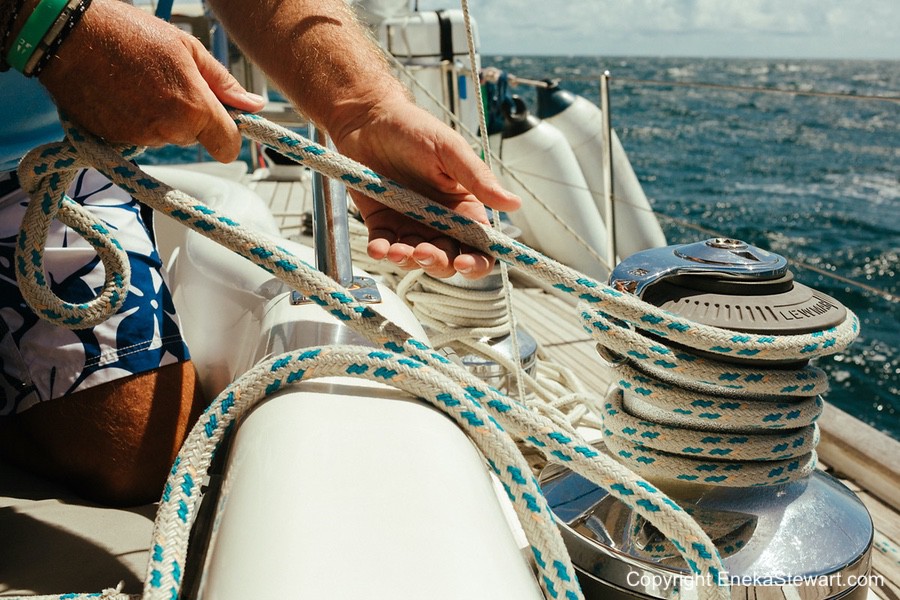
For everyone to work together they all need to be singing from the same hymn sheet.
Interestedly, not everyone in the racing world uses the same terms though…When we had an Australian on our boat during a race (regatta) he had different terms for almost everything – I had to learn another language AND race at the same time. He yelled out ‘Topper Kim – TOPPER’. I thought, what the heck is ‘Topper’? (It’s the topping lift)
But when the big picture is to set sail with your partner/your family there are no hard set rules (other than perhaps to find fulfillment in your choice to set sail?! Let’s not lose sight of this objective – The Master Plan.)
Over time it’s nice to know the name of everything and to use it confidently but for most people, the very basics are good enough.
I’ve started a list of the most commonly used terms on a boat and have provided easy/quirky ways to remember them. If you find this useful, I’ll keep adding more – just let me know by leaving a comment below.
If you’re going to do a course or sail with other people, print yourself out a visual diagram way before you need to learn the terms. Every day have a look over them and then use my explanations below as a way to remember terms.
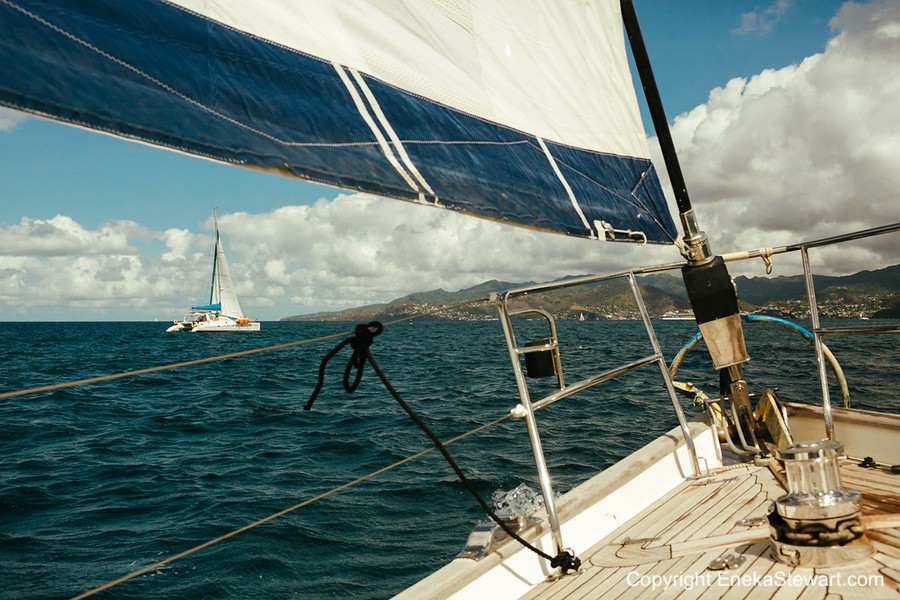
Sailing Terms You Need To Know
Mast – The mast is the big tall pole centrally located that holds up the sails. Some boats have one mast and others have more. I’m going to assume you know what a mast is already. The key function of the mast is to hold the sails. There are loads of ropes tied to the mast making things look complicated but there are only two main types of ropes that are used most of the time. One type is used to hold up the front sail(s) and another rope is used to hold up the back sail(s). Ropes that pull things up the mast, like the sails, are called Halyards. (“Hal! Get down from the top of the mast and play in the YARD instead”)
Boom – that’s the sound you’ll hear when the big long thing at the bottom of the mainsail hits your head. Some booms hold the sail and the sail gets pulled up the mast with a rope (Halyard). In other configurations, the mainsail is inside the mast and gets rolled in/out and is held down into the boom with another rope.
Sails – there are two sails that are used on a standard sailboat. The front sail is most commonly called the Jib, Genoa, or Headsail. I use ‘headsail’ because it makes sense – it’s at the head of the boat. There are also other terms used for headsails but no matter what, it’s always a headsail. You can’t go wrong with that term. And the one that’s attached to the boom, that is always at a right-angle, is the Mainsail or simply, the ‘Main’. Think – the main reason we’re sailing is that the Main is up 🙂
All the other sails that can be used on a standard sailboat are extra’s and in the cruising world, you won’t see them too often. They’re called spinnakers, asymmetrical’s, symmetrical’s, cruising chute, staysail, storm jib, and so on. The extra sails are only used in special situations rather than your everyday journey.
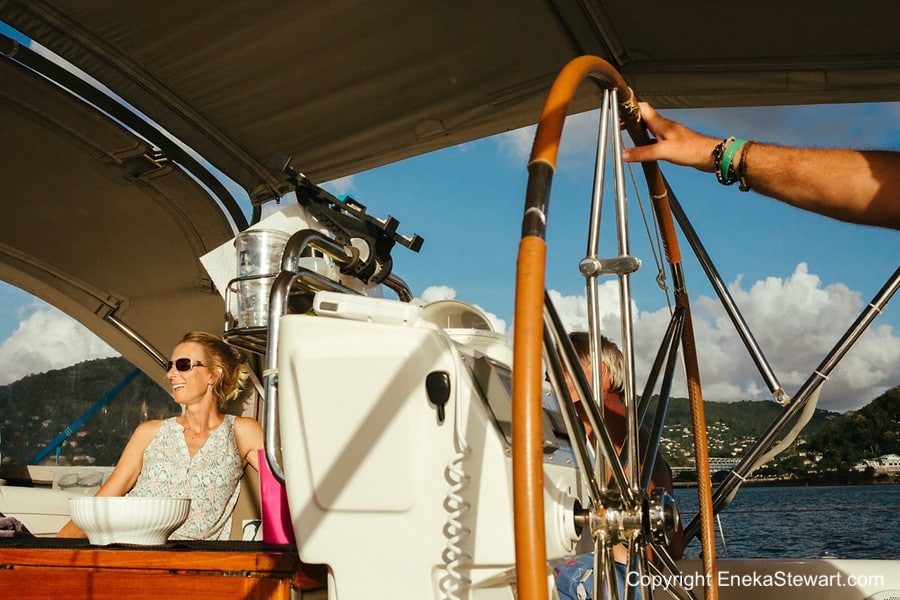
More Sailing Terms You Need To Know
Reefing – You’ll hear someone say, ‘I put one reef in,’ or ‘I had the sail reefed,’ or ‘I saw a storm on the horizon so I put two reefs in.’ Reefing means that the sail, or sails, have been made smaller by taking some of the sail down or rolling some of the sail in. Both the headsail and the mainsail can be reefed or made smaller. By reducing the amount of sail out, the less likely the boat will be subjected to too much wind, making for an uncomfortable ride. Sails can be reefed by rolling them in a bit or by using one of several reefing ropes. Our boat has three reefing ropes and three reefing points – all we do is let the mainsail down a bit so there’s extra sail sitting in the boom and we tie it down with the reefing ropes (otherwise called reefing ‘lines’).
Rigging. There is the rig and that’s all the pieces and parts that come off the mast keeping it upright. And then there’s the Running Rigging and that’s all the ropes that run through the rig that control the sails – taking them up, holding them down on the deck and so forth. Think of an oil rig and superimpose an image of a sailboat mast and fixings over the top.
Types Of Rig. There are four main rig configurations of boats. The most popular is she Sloop. There are only two sails just like there’s only two o’s in the word Sloop. Our boat is a Sloop (most of the time). Then there’s a cutter. This boat has one mainsail and two headsails. Imagine the two T’s in Cutter leaning over to make the two forward sails. Our boat rig can be made into a cutter when we want to sail a second headsail. The third most common rig is a Ketch. It’s a sloop with an extra mast (Mizzen) and sail in the back that’s lower than the front sail. That poor little back sail is always trying to Ketch-up with the front sails but never quite makes it. If it’s not a Ketch it’s a Yawl and the difference comes down to where the Mizzen is located – most people can’t figure this out. Finally, there’s the Schooner. Like the Ketch, the Schooner has two masts but the front mast is lower than the back mast. Schooners usually have loads of sails all over the place – they’re big boats.
Sheets. This word really drives me nuts. Sheets are the ropes you use when pulling the bottom of the sail out and to one side of the boat or the other. Halyards pull the sails up and sheets control the bottom of the sail. Sheets is an important word to remember as these ropes are used all the time when you’re sailing. The Main sheet controls the back of the Main – whether it’s to the left, center or right. The Headsail sheets are attached to the bottom corner of the sail and are pulled either to the left or the right of the boat depending on where you’re heading and which way the wind is hitting the boat.
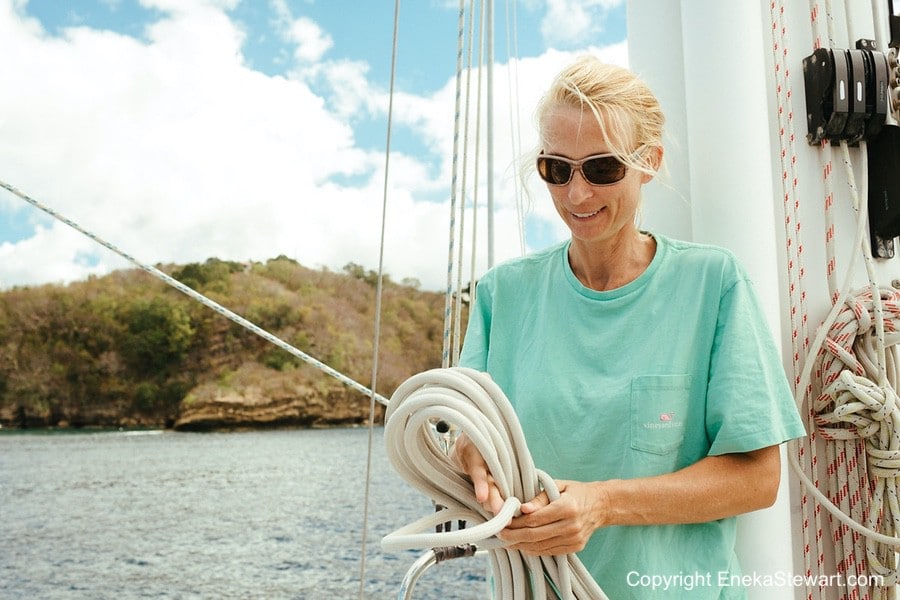
And More Sailing Terms You Need To Know
Winches. Winches are those round things that the ropes go around. They help to pull sails up, in and let them out (in a controlled manner). Winches pull in inch by inch 🙂 Some are manual where you have to use a removable winch handle to turn the winch. Winching up a sail provides a great workout. Other winches are electric and work with a push button.
Locations. Instead of having front, back, left and right we have Bow (As in, ‘Bow down before me and I might just let you live’ rather than the pretty bow in that cute girl’s hair), Stern, Port, and Starboard. To remember these terms, visualize a big red bow in the front of the Bow. For Stern – Stern rhymes with ‘turn’ – it’s the back of the boat, where the steering wheel and rudder are located, that turn the boat. The way that I remember Port works for me but it’s a bit random. I think that the word Left has four letters in it and so does Port. So – to know my left and right I make the letter L on my left hand (Yes – I’m 44 years old and still need to do that) and then I think Port, four letters…that’s Left. Finally, there’s Starboard. Picture looking at the front of the boat (the bow) while sitting at the back of the boat (Stern) and seeing a movie star magically stepping onto the right side of the boat (I picture Dustin Hoffman), on the Starboard side of the boat. A star has boarded the boat on the right side – StarBoard.
You then have Ahead, Astern and Abeam. Ahead (forward) and Astern (back) make sense but what is Abeam? Well, when the wind is hitting the boat on the side you’d say, the wind is to our beam or we’re sailing a Beam Reach. The width of the boat is the beam of the boat.
Points of Sail. Imagine a boat placed in the middle of a circle. Then imagine that the wind is coming from different directions – it’s coming from the front (12:00), then the left top side (11:00), then from the side (9:00)…then the other side (3:00) and then from the back (6:00). There are set terms for each area that the wind is hitting the sails from.
When sailing into the wind, rather than having it come from behind you, you have to be at an angle. The boat will not sail directly into the wind or even slightly off. You need to turn the boat a bit to the left or the right before it starts moving.
You also need to have your sails quite tight to the boat – not let out all loose and floppy. This is called Close Hauled – the sails are Hauled in tight and you’re sailing Close to not being able to sail at all! If the wind is hitting the boat on the Beam (or the side of the boat) it’s called a Reach.
The sails are let way out, it’s usually a very pleasant point of sail, however, you really have to Reach those sails way, way, way out to get them to get all the wind. REEEEEAAAAAACCCCCHHHH.
There’s a Beam Reach (wind coming on the side) and a Broad Reach. A Broad Reach is when the wind is coming from the back corner of the boat (on either side). Broad means ‘spacious’ – so for a Broad Reach the wind moves from the beam to the come from the back corners – it’s spaces it self backwards. And last but least there’s Running. When you’re running, you’re sailing directly down wind.
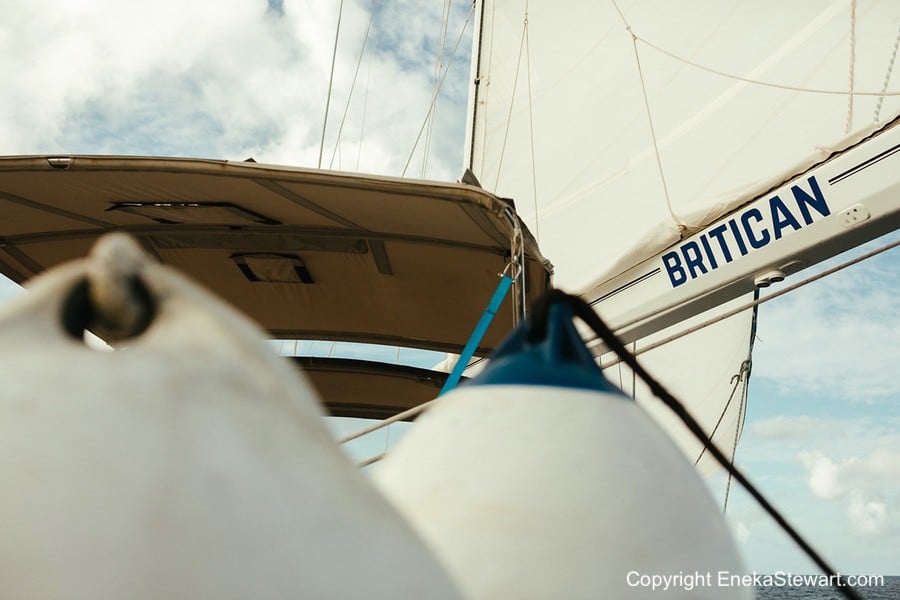
Other How-To or Questions Answered Resources
- Questions Answered About Liveaboard Life
- Three Things That All Liveaboards Must Know
- The 11 Secrets To Long Term Cruising
Get On The Fast Track To Living Your Sailing Dreams
Join the Britican Club and get our personal support. Get premium content (to see some examples, visit our Members Only area) and access to all of our helpful sailing guides (view all the guides here) and a direct email/phone line to Simon, Kim and Sienna to discuss how we can help you to make your sailing dreams come true. More here: Britican Club
Come sailing with us – Britican Sailing Experience. Come join us for a week-long sailing experience! We’ve opened our boat to singles, couples, and families (up to four people) for a week-long liveaboard experience. Come enjoy the tropical beauty of Grenada and the Grenadines while learning how to sail, understanding what it takes to become a liveaboard boatie and much more. Get the full scoop here: The Britican Experience
Any Questions or Comments?
Or how about easy ways to remember sailing terms! Leave your ideas below 🙂
I love this!!! AND after 2 and a half years as a cruiser…I learnt something form it! great article xx
Thank you Lynette 🙂
Another useful point about Port – the drink Port is red.
Port is red, Starboard is green
I love it! That’s a good one Doug 🙂
Thank you so much. Very easy to understand for someone who is just learning and you made it very simple to remember. I wish the rest of sailing was this easy to understand.
Thank you Lori 🙂 Kim